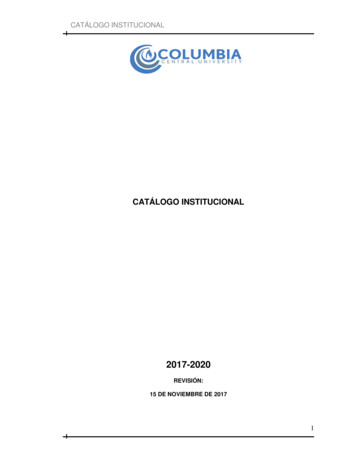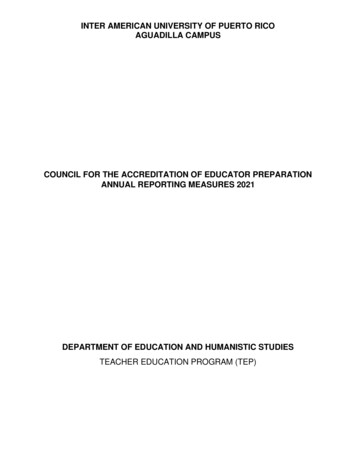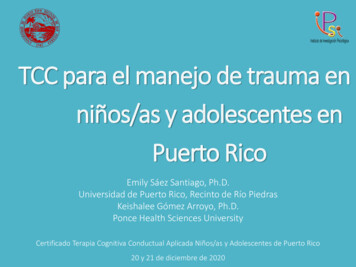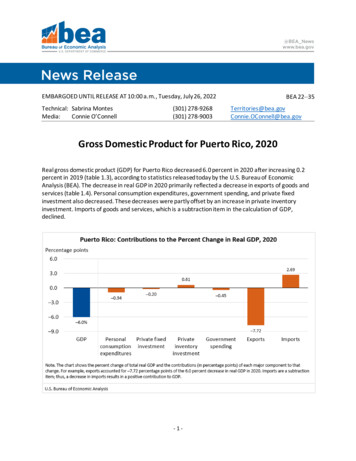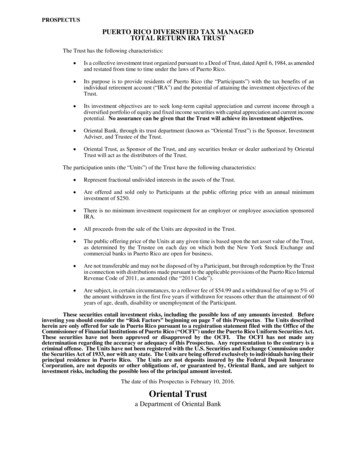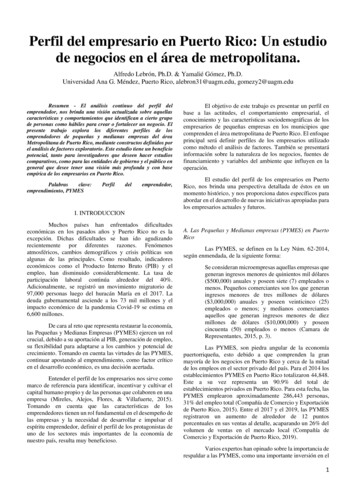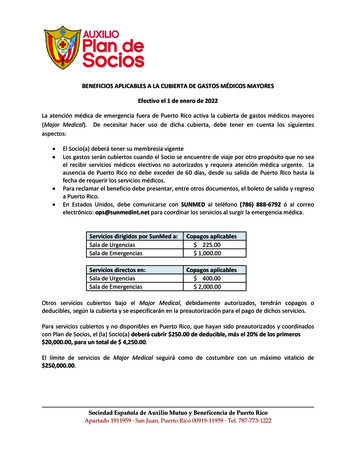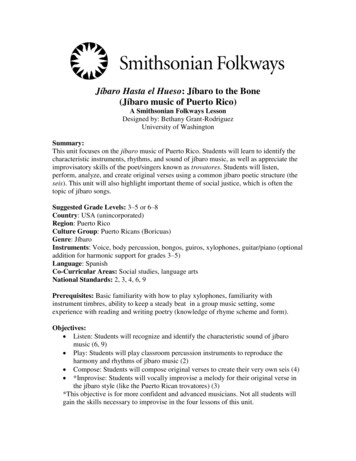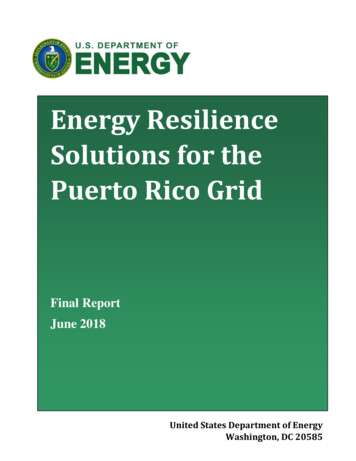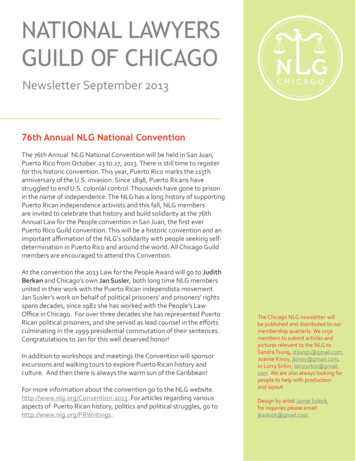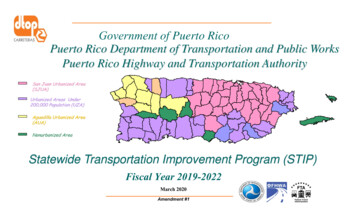
Transcription
Government of Puerto RicoPuerto Rico Department of Transportation and Public WorksPuerto Rico Highway and Transportation AuthoritySan Juan Urbanized Area(SJUA)Urbanized Areas Under200,000 Population (UZA)Aguadilla Urbanized Area(AUA)Nonurbanized AreaStatewide Transportation Improvement Program (STIP)Fiscal Year 2019-2022March 2020Amendment #1
Government of Puerto RicoPuerto Rico Department of Transportation and Public WorksPuerto Rico Highway and Transportation AuthorityStatewide Transportation Improvement Program (STIP)Fiscal Years 2019-2022The preparation of this document was financed in part through a grant from the U.S. Department of Transportation, Federal Transit Administration, andFederal Highway Administration under Chapter 53 of 49 U.S.C. and 23 U.S.C.
INTRODUCTIONThe Puerto Rico Department of Transportation and Public Works (PRDTPW), as theumbrella agency for transportation, and the Puerto Rico Highways and TransportationAuthority (PRHTA) prepare this Statewide Transportation Improvement Program(STIP), which includes the proposed distribution, by projects, of the federal fundsassigned to Puerto Rico for the fiscal years of 2019 to 2022, through programs ofthe Federal Highway Administration (FHWA) and the Federal TransitAdministration (FTA), to which it is presented for joint approval.This STIP includes transit and highway projects for both urbanized and non-urbanized(rural) areas, thus covering all of Puerto Rico. Programmed projects result from aplanning process that is in accordance with 23 USC 420 and 511, 49 USC and all otherrelevant federal or Commonwealth legislation. The portion of the STIP corresponding tothe metropolitan and urbanized areas was developed in cooperation with theMetropolitan Planning Organization (MPO). The members of the MPO includerepresentatives from municipal governments (Mayors) and State involved intransportation issues as well as operators of Mass Transportation Systems and StateLevel Planning Agencies. The MPO’s were provided with estimates of available Federalfunds which can be utilized in developing the Transportation Improvement Programs(TIP). The TIP’s were included without modification in the STIP, once approved by theMPO.The PRDTPW provides for public involvement in development of this STIP. As part ofthe public participation process and complying with the federal regulations, thePRDTPW also considers petitions of projects from the municipalities, agencies and thegeneral public.The STIP includes:1- A list of priorities transportation projects proposed to be carried out in thefirst 4 years.2- Cover a period of not less than 4 years.3- Contain only projects consistent with the statewide plan.Is financially constrained by year and include financial information to demonstratewhich projects are to be implemented.This document includes the priority list of proposed projects that are to be undertaken byyear, consistent with the transportation plan and are financially constrained. Projectsincluded in the Annual Element can be implemented using the allocation of fundsfor Fiscal Year 2019 and carryover funds.General transportation priorities are defined as follows:12345678-Regional projects, projects which involve several municipalitiesPublic transportation projects of high impact and investmentCarryover projectsContinuity projectsConstruction of transportation facilitiesImprovements of existing transportation facilitiesConstruction of shelters/stop for transportation servicesAcquisition of transit and paratransit vehicles to start, maintain or expandlocal and regional services9- Preventive maintenance cost for transit vehicles10- Operational assistant to paratransit services11- Construction of facilities for maintenance garage for transit vehicles12- Transit enhancement13- Transit security and transit safety projects14- Transportation projects for elderly and handicapped15- Capital and operating expenses that support new public transportationservices and alternatives beyond those required by the Americans withDisabilities Act of 1990 (ADA)16- Capital, planning, and operating expenses that support the development andmaintenance of transportation services designed to transport low-incomeindividuals to and from jobs and activities related to their employment and tosupport reverse commute projects.17- State of Good Repair Program18- Bus and Bus Facilities ProgramThrough an established process as describe in the State Management Plan (SMP), thePublic Involvement Plan (PIP) and the MPO Internal Regulations,see eral/), the State solicits andidentifies projects from Urbanized and Non-Urbanized, to be include in TIP/STIPPrograms.I
The STIP is presented in self-explanatory tables with projects organized by priority bymode of transportation and type of Highways projects. This document is divided in twomayor components, the mass transportation projects, carryout with FTA funds and thehighways projects, carryout with FHWA funds. Both components are divided byUrbanized and Non–Urbanized projects.The mass transportation projects areidentifying by the different FTA programs, being the carryover projects the first listed oneach Program.The Annual Element is presented as part of the Four Year Program.Since the beginning of the requirement that MPO’s be constituted and because of thewide powers and resources that the PRDTPW has in our relatively small Island, thisAgency was designated as the operational and technical staff of the MPO for all theurbanized areas in Puerto Rico.To assure a forum for cooperative decision-making in the planning process, this MPOmakes policy and programming decisions through three Policy Committees.The first Policy Board Committee is for the San Juan Urbanized Area (SJUA), definedby the 2010 Census as falling in the funding category of areas with over one millioninhabitants and comprising the following thirty-eight (38) municipalities:Comprising Municipalities – San Juan Urbanized Area (SJUA)Aguas ovisCatañoHumacaoPatillasCayeyJuncosRío GrandeCialesLas PiedrasSalinasSan JuanSan LorenzoToa BajaToa AltaTrujillo AltoVega AltaVega BajaYabucoaThe second Policy Board Committee is for Urbanized Area of Aguadilla (AUA), whichfalls in the funding category of areas with over 200,000 and less than one millioninhabitants. It is defined as comprising the following eleven (11) municipalities:Comprising Municipalities – Aguadilla Urbanized Area (AUA)AguadaCamuyLas MaríasAguadillaIsabelaMocaAñascoLaresSan SebastiánRincónUtuadoThe third Policy Board Committee is for Urbanized Areas Under 200,000 Population(UZA), which falls in the funding category of areas with under 200,000 and over than50,000 in population. It is defined as comprising the following twenty-nine (29)municipalities:Urbanized maJuana DíazMayagüezPonceSan Germán – Cabo RojoYaucoComprising Municipalities – UZAArecibo, Camuy, Hatillo, QuebradillasCeiba, Fajardo, Luquillo, NaguaboArecibo, Barceloneta, Florida, ManatíArroyo, Guayama, Patillas, SalinasJuana Díaz, VillalbaAñasco, Hormigueros, MayagüezPonceCabo Rojo, Lajas, Sabana Grande, San GermánGuánica, Guayanilla, Peñuelas, YaucoThe Policy Board Committee also includes representatives from the following agenciesinvolved with the transportation issues:1. Voting Members:i. The Secretary of the Puerto Rico Department of Transportationand Public Works (PRDTPW)ii. The Executive Director of the Puerto Rico Highways andTransportation Authority (PRHTA)iii. The Executive Director of the Puerto Rico Integrated TransitAuthority (PRITA)II
iv. The Executive Director of the Maritime TransportationAuthority (MTA)v. The President and General Manager of the MetropolitanBus Authority (MBA)vi. The Executive Director of the Port Authority (PA)vii. The Chairman of the Planning Board (PB)viii. The President of the Public Services Commission (PSC)ix. The Executive Director of the Permissions Management Office(PMO)x. The President of the Environmental Quality Board (EQB)xi. The Secretary of the Department of Environmental and NaturalResources (DENR)xii. Puerto Rico Tourism Company (PRTC)xiii. Puerto Rico Emergency Management Agency (PREMA)2. Non–voting Members:i. The Division Administrator, Region I of the Federal HighwayAdministration (FHWA)ii. The Regional Administrator, Region IV of the Federal TransitAdministration (FTA)As a result of the 2010 Census, the urbanized area boundaries in Puerto Rico were notsignificantly change, with some previously defined urban areas being subdivided whileothers were consolidated and expanded and new ones were designated. The results ofthese changes is that only 6 municipalities, out of the 78 that comprise theCommonwealth, do not have within their geographical boundaries any part of the eleven(11) urbanized or metropolitan areas currently designated for Puerto Rico, and thereforedo not participate in the technical and policy committees of the MPO. These Six (6)non-urbanized municipalities are:Comprising MunicipalitiesAdjuntasCulebraJayuyaMaricaoSanta IsabelViequesRecognizing that these rural or non-urbanized municipalities have the right to participatein the ongoing process of developing a new Statewide Transportation Plan (STP), and inorder to follow a logical planning process for Puerto Rico’s transportation system, thePRDTPW/PRHTA develop the STP and the Urbanized Areas’ Long RangeTransportation Plans (LRTP’s) within a regionalization scheme that incorporates the sixnon-urbanized municipalities within regional transportation plans.PROJECT EVALUATIONSThe following criteria were utilize to evaluated the petitions received to be consider inthe programming for FY 2019-2022 TIPs/STIP: Compliance with FAST Act planning factors; andConsistency with Long Range Transportation Plan.The PRHTA Central Planning and Coordination Work Group (CPCWG) with the SanJuan, Aguadilla and UZA Technical Committee reviewed and submitted forconsideration of the PRMPO the list of projects to be including in the TIPs/STIP.FIXING AMERICA’S SURFACE TRANSPORTATION (FAST) ACTFixing America’s Surface Transportation (FAST) Act was signed by President Obamaon December 4, 2015. The FAST Act maintains its focus on safety, keeps intact theestablished structure of the various highway-related programs we manage, continuesefforts to streamline project delivery and, for the first time, provides a dedicated sourceof federal dollars for freight projects. FAST Act is the federal authorization for federalhighway and transit programs. FAST Act creates a streamlined, performance-based, andmultimodal program to address the many challenges facing the U.S. transportationsystem. FAST Act builds on and refines many of the highway, transit, bike, andpedestrian programs and policies established in 1991.FEDERAL HIGHWAY ADMINISTRATION (FHWA)The FAST Act largely maintains current program structures and funding shares betweenhighways and transit. It is a down-payment for building a 21st century transportationsystem. The law also makes changes and reforms to many Federal transportationIII
programs, including streamlining the approval processes for new transportation projects,providing new safety tools, and establishing new programs to advance critical freightprojects.Below is a more detailed summary of some FAST Act provisions.PROJECT DELIVERY: DOT has been a leader in reducing the bureaucratic red tapethat can stall and delay critical transportation projects from moving forward. The FASTAct adopted a number of Administration proposals to further speed the permittingprocesses while still protecting environmental and historic treasures and also codifyingthe online system to track projects and interagency coordination processes.FREIGHT: The FAST Act would establish both formula and discretionary grantprograms to fund critical transportation projects that would benefit freight movements.These programs are similar to what the Administration proposed and will for the firsttime provide a dedicated source of Federal funding for freight projects, includingmultimodal projects. The Act emphasizes the importance of Federal coordination tofocus local governments on the needs of freight transportation providers.INNOVATIVE FINANCE BUREAU: The FAST Act establishes a new NationalSurface Transportation and Innovative Finance Bureau within the Department to serveas a one-stop shop for state and local governments to receive federal funding, financingor technical assistance. This builds on the work of the Department’s Build AmericaTransportation Investment Center and provides additional tools to improve coordinationacross the Department to promote innovative finance mechanisms. The Bureau is alsotasked with responsibility to drive efficiency in the permitting process, consistent withour request to establish a dedicated permitting office.TIFIA: The TIFIA Loan program provides important financing options for largeprojects and public-private partnerships. The FAST Act includes organizational changesthat will provide an opportunity for important structural improvements with the potentialto accelerate the delivery of innovative finance projects. However, FAST’s cut to theTIFIA program could constrain growth in this area over the course of the bill.SAFETY: The FAST Act includes authority sought by the Administration to prohibitrental car companies from knowingly renting vehicles that are subject to safetyrecalls. It also increased maximum fines against non-compliant auto manufactures from 35 million to 105 million. The law also will help bolster the Department’s safetyoversight of transit agencies and also streamlines the Federal truck and bus safety grantprograms, giving more flexibility to States to improve safety in these areas. However, weknow the bill also took a number of steps backwards in terms of the Department’s abilityto share data with the public and on the Department’s ability to exercise aggressiveoversight over our regulated industries.TRANSIT: The FAST Act includes a number of positive provisions, includingreinstating the popular bus discretionary grant program and strengthening the BuyAmerica requirements that promote domestic manufacturing through vehicle and trackpurchases.LADDERS OF OPPORTUNITY: The Act includes a number of items that strengthenworkforce training and improve regional planning. These include allocating slightlymore formula funds to local decision makers and providing planners with additionaldesign flexibilities. Notably, FAST makes Transit Oriented Development (TOD)expenses eligible for funding under highway and rail credit programs. TOD promotesdense commercial and residential development near transit hubs in an effort to shore uptransit ridership and promote walkable, sustainable land use.FAST Act re-establishes the Puerto Rico Highway Program (PRHP) in 23 U.S. C.165(b). This is an allocated program under the Territorial and Puerto Rico HighwayProgram to carry out under provisions of Chapter 1 Title 23 of the U. S. Code. PuertoRico is treated as a State except for provisions related to apportionment or as otherwiseprovided. The funds must be for activities under National Highway PerformanceProgram (50%), Highway Safety Improvement Program (25%) and any activities underChapter 1 of Title 23(25%).FEDERAL TRANSIT ADMINISTRATION (FTA)MAP-21 transit program provisions further several important goals, including safety,state of good repair, performance, and program efficiency. MAP-21 gives the FederalIV
Transit Administration (FTA) significant new authority to strengthen the safety of publictransportation systems throughout the United States. The Act also puts new emphasis onrestoring and replacing our aging public transportation infrastructure by establishing a newneeds-based formula program and new asset management requirements. In addition, itestablishes performance-based planning requirements that align Federal funding with keygoals and tracks progress towards these goals.The Performance Measures and Targets for the TAM are divided into fourcategories of transit assets: rolling stock, facilities, infrastructure and equipment. Aspart of the Final Rule for the TAM, PRHTA established performance targets forthese performance measures:Finally, MAP-21 improves the efficiency of administering grant programs byconsolidating several programs and streamlining the major capital investment grantprogram known as “New Starts.” All these changes continue within the FAST Act.NEW PROGRAMSSafetyMAP-21 grants FTA the authority to establish and enforce a new comprehensiveframework to oversee the safety of public transportation throughout the United States. FTAwill develop safety performance criteria for all modes of public transportation (rail, bus, etc.).The new law requires all recipients of FTA funding to develop agency safety plans that includeperformance targets, strategies, and staff training. For rural recipients, the plan may be draftedby the State. For small urban systems, FTA must issue a rule designating which small urbansystems may have their safety plans drafted by the State. These measures and targets must beincorporated into metropolitan and statewide transportation plans and transportationimprovement programs. MAP-21 also grants FTA enforcement authority and permits FTA toissue directives, require more frequent oversight of transit systems, impose more frequentreporting requirements, and require that formula grant funds be spent to correct safetydeficiencies before funds are spent on other projects.TRANSIT ASSET MANAGEMENTTransit Asset Management (FTA)In 2016, the Federal Transit Administration (FTA), established a requirement for all publictransportation providers that receive federal transit assistance to develop a TAM. Accordingto 49 CFR Section 625.5, transit asset management is: “the strategic andsystematic practice of procuring, operating, inspecting, maintaining, rehabilitating, andreplacing transit capital assets to manage their performance, risks, and costs over their lifecycles, for the purpose of providing safe, cost-effective, and reliable public transportation”.The Final Rule for the TAM requires transit providers to collect and use asset condition data, settargets, and develop strategies to prioritize investments to meet their goals. Following theprinciples of Performance-Based Planning for management of transit assets,systems andnetworks must be part of the planning and management process for the PRHTA. Whenever aTIP/STIP update or amendment, updated targets will be included .The projects included in theamendedSTIP will be in accordance to achieving the targets.V
Statewide Transportation Improvement Program (STIP) Fiscal Years 2019-2022Table 1: Pavement Inventory SummarySystemTRANSIT ASSET MANAGEMENT (FHWA)The Federal Highway Administration (FHWA) issued a final rule requiring the development andimplementation of a risk-based asset management plan for the National Highway System (NHS)to improve or preserve the condition of the assets and the performance of the system. The rulebecame effective in October 2, 2017. Asset management refers to a strategic and systematicprocess of operating, maintaining, and improving physical assets, with a focus on both engineeringand economic analysis based upon quality information, to identify a structured sequence ofmaintenance, preservation, repair, rehabilitation, and replacement actionsthat will achieve and sustain a desired state of good repair over the life cycle of the assets atoptimum cost (23 CFR Part 515 § 515.5).Puerto Rico Transportation Asset Management (PRTAM) program was established in 2017with the procurement of the PRTAM plan (PRTAMP). The PRTAMP focus on the NHSpavements, although Non-NHS pavements within the Highway Performance MonitoringSystem (HPMS) are also considered (see Table 1), and on the National Bridge Inventory(NBI) bridges (see Table 2). The PRTAMP aims to implement a strategic approach to planning,programming, engineering, financing, managing, maintaining, and operating physical assetswith the objective of providing the required level of service in the most cost-effective manner.The Initial PRTAMP was delivered and certified in 2018. The Final TAMP is due June 30, 2019.The PRTAMP is developed in accordance with federal laws and regulations, such as MovingAhead for Progress in the 21st Century Act (MAP-21) and FixingAmerica's Surface Transportation ACT (FAST). The components ofhe PR-TAMP are: Objectives, Measures and Targets for Asset Condition Asset Inventory and Conditions Performance Gap Identification and Analysis Life Cycle Planning Considerations Risk Management Analysis Financial Plan Investment StrategiesLength sNHS pistasTOTALLane MilesMetropistasTotalTable 2:Bridge Inventory ,118,2071,6981,002,120Metropistas85,916Autopistas de s de PRPRHTATOTALDeck Area (Sq. Mts.)529SubtotalNON-NHSAmountMetropistasAutopistas de PRTotalVI
Statewide Transportation Improvement Program (STIP) Fiscal Years 2019-2022Emergency Relief:This new program (Section 5324) assists States and public transportation systems withemergency-related expenses. Emergencies are defined as natural disasters affecting a widearea or a catastrophic failure from an external cause for which the governor of a State hasdeclared an emergency (and the Secretary of Transportation has concurred) or the Presidenthas declared a major disaster. The program funds capital projects to protect, repair,reconstruct, or replace equipment and facilities.It also funds transit agency operating costs related to evacuation, rescue operations,temporary public transportation service, or changing public transportation routeservice before, during, or after an emergency in an area directly affected. The grantsonly cover expenses not reimbursed by the Federal Emergency Management Agency(FEMA). The program will provide immediate funding, similar to the FHWAemergency program. Funding will be appropriated by Congress as needed.Transit-Oriented Development Planning PilotMAP-21 creates a new discretionary pilot program for transit-oriented development(TOD) planning grants. Eligible activities include comprehensive planning in corridorswith new rail, bus rapid transit, or core capacity projects. The comprehensive plansshould seek to enhance economic development, ridership, and other goals; facilitatemultimodal connectivity and accessibility; increase access to transit hubs for pedestrianand bicycle traffic; enable mixed-use development; identify infrastructure needsassociated with the project; and include private sector participation.The following sections describe some of the various funding sources for FTA programs,which are including in this document: §5307 Urbanized Area Formula Grants§5310 Enhanced Mobility of Seniors and Individuals with Disabilities§5311 No-Urbanized Area Formula Grants§5337 State of Good Repair Grants§5339 Bus and Bus Facilities GrantsURBANIZED AREA FORMULA GRANTS (SECTION 5307)The PRHTA is the designated recipient of funds apportioned to the Puerto Rico UZA.The funds are apportioned based on legislative formulas, with different formulasapplying to UZAs with populations less than 200,000. The Puerto Rico UZAapportionment formula is based on population and population density statistics from themost recent decennial census.This program provides grants to urbanized areas to support public transportation.Funding is distributed by formula based on the level of transit service provision,population, and other factors. The section 5307 provides federal funds for capital,planning, job access and reverses commute projects, and, in this case, operatingassistance for public transportation in urbanized area with a population of less than200,000. The program remains largely unchanged with a few exceptions:Job access and reverse commute activities now eligibleActivities eligible under the former Job Access and Reverse Commute (JARC) program,which focused on providing services to low-income individuals to access jobs, are noweligible under the Urbanized Area Formula program. These include operating assistancewith a 50 percent local match for job access and reverse commute activities. In addition,the urbanized area formula for distributing funds now includes the number of lowincome individuals as a factor. There is no floor or ceiling on the amount of funds thatcan be spent on job access and reverse commute activities.VII
Expanded eligibility for operating expenses for systems with 100 or fewer busesMAP-21 expands eligibility for using Urbanized Area Formula funds for operatingexpenses. Previously, only urbanized areas with populations below 200,000 wereeligible to use Federal transit funds for FTA of funding for operating expenses. UnderMAP-21, a special rule allows recipients in urbanized areas with populations of 200,000or above and that operate 100 or fewer buses in fixed route service during peak hours, toreceive a grant for operating assistance subject to a maximum amount per system asexplained below:a. Public transportation systems that operate a minimum of 76 buses and amaximum of 100 buses in fixed route service during peak service hours mayreceive operating assistance in an amount not to exceed 50 percent of the share ofthe apportionment that is attributable to such systems within the urbanized area,as measured by vehicle revenue hours.b. Public transportation systems that operate 75 of fewer buses in fixed routeservice during peak service hours may receive operating assistance in an amountnot to exceed 75 percent of the share of the apportionment that is attributable tosuch systems within the urbanized area, as measured by vehicle revenue hours.Eligibility for Safety Certification TrainingThe section 5307 funds are permitted to use not more than 0.5 percent of their formulafunds under the Urbanized Area Formula Program to pay not more than 80% of the costof participation for an employee who is directly responsible for safety oversight toparticipate in public transportation safety certification training. Safety certificationtraining program requirements will be established in accordance with section 5329.ENHANCED MOBILITY OF SENIORS AND INDIVIDUALS WITHDISABILITIES PROGRAM (SECTION 5310)This program provides formula funding to increase the mobility of seniors and personswith disabilities. Funds are apportioned based on the commonwealth share of thetargeted populations and are now apportioned to the commonwealth for all areas fewerthan 200,000 and large urbanized areas (over 200,000). The former New Freedomprogram (5317) is folded into this program. The New Freedom program provided grantsfor services for individuals with disabilities that went above and beyond therequirements of the Americans with Disabilities Act (ADA). Activities eligible underNew Freedom are now eligible under the Enhanced Mobility of Seniors and Individualswith Disabilities program.Projects selected for funding must be included in a locally developed, coordinated publictransit human services transportation plan; and the competitive selection process, whichwas required under the former New Freedom program, is now optional. At least 55percent of program funds must be spent on the types of capital projects eligible under theformer section 5310 -- public transportation projects planned, designed, and carried outto meet the special needs of seniors and individuals with disabilities when publictransportation is insufficient, inappropriate, or unavailable. The remaining 45 percentmay be used for: public transportation projects that exceed the requirements of the ADA;public transportation projects that improve access to fixed-route service and decreasereliance by individuals with disabilities on complementary paratransit; or, alternatives topublic transportation that assist seniors and individuals with disabilities. Using thesefunds for operating expenses requires a 50 percent local match while using these fundsfor capital expenses (including acquisition of public transportation services) requires a20 percent local match.STATE OF GOOD REPAIR GRANTS(SECTION 5337)MAP-21 establishes a new grant program to maintain public transportation systems in astate of good repair. This program replaces the fixed Guideway modernization program(Section 5309).Funding is limited to Fixed Guideway systems (including rail, bus rapid transit, andpassenger ferries) and high intensity bus (high intensity bus refers to buses operating inhigh occupancy vehicle (HOV) lanes.) Projects are limited to replacement andrehabilitation, or capital projects required to maintain public transportation systems in astate of good repair. Projects must be included in a transit asset management plan toreceive funding. The new formula comprises: (1) the former Fixed Guidewaymodernization formula; (2) a new service-based formula; and (3) a new formula forbuses on HOV lanes.VIII
BUS AND BUS FACILITIES FORMULA GRANTS(SECTION 5339)A new formula grant program is established under Section 5339, replacing the previousSection 5309 discretionary Bus and Bus Facilities program. This program is a source offunding for the urbanized area, but replaces the previous discretionary program underwhich the transit system was able to obtain several large grants. The program providesfunding to replace, rehabilitate, and purchase buses and related equipment as well asconstruct bus-related facilities.LONG RANGE TRANSPORTATION PLAN CONSISTENCYA prima
planning process that is in accordance with 23 USC 420 and 511, 49 USC and all other . The Executive Director of the Puerto Rico Highways and . v.The President and General Manager of the Metropolitan Bus Authority (MBA) vi. The Executive Director of the Port Authority (PA) vii. The Chairman of the Planning Board (PB) viii. The President of .

